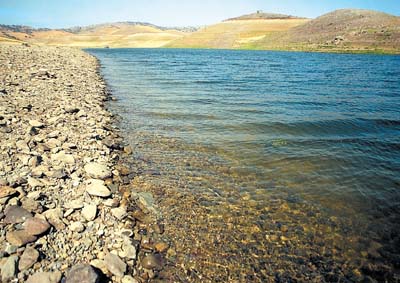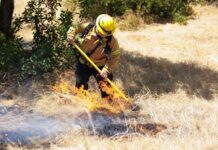By JOHN ROGERS
LOS ANGELES
Seventy-six years after the invention of the modern sprinkler helped revolutionize farming, a professor of environmental engineering is pointing a laser beam across an alfalfa crop in Southern California’s bone-dry Imperial Valley, looking for a better way to conserve the millions of gallons of water sprayed each year on thirsty crops.
Jan Kleissl and a handful of his students at the University of California, San Diego, have rigged up a telescope-looking contraption called a large aperture scintillometer to study exactly how much water crops lose to evaporation and the peak times that water disappears.
The hope is to give farmers a more accurate, up-to-date reading of how efficiently their crops are using water than current technology allows.
“What’s new about our approach is the monitoring side of it,” Kleissl said by phone from his office. “We’re trying to improve on that.”
Some advancements in irrigation have focused on the water delivery system – such as Southern California grower Orton Englehart’s 1932 invention of the horizontal action impact drive sprinkler, which he patented the following year.
But while most farmers are experts at managing their irrigation by sight, recent years’ droughts have called for more sophisticated ways to use – and save – water.
Water became an even more valuable commodity in California last year, when a federal judge ordered federal and state agencies to restrict pumping in the Sacramento-San Joaquin River Delta to protect the threatened delta smelt, severely cutting the growers’ supply.
Further restrictions could result from last month’s decision by state fish and wildlife managers to limit pumping to protect another native fish, the longfin smelt.
These shortages are prompting researchers to devise new ways to determine when to irrigate and how much water to use, said Khaled Bali, an irrigation expert for the University of California Cooperative Extension office in Imperial County.
“There’s not enough water to go around,” he said.
San Diego County farmer Bob Polito, who was forced to remove 10 of his 60 acres of citrus and avocado trees from production after last year’s pumping restrictions, said high-tech irrigation aids have so far been too expensive for him to use. But he said the increasing scarcity of water may force him to invest in technology to monitor his trees’ water efficiency.
“Anything that gives you an accurate accounting on that score would be a help to farmers,” Polito said.
Researchers are also testing a device that measures the velocity at which sap creeps up trees. When the sap’s movement slows, growers would know that the trees need less water and reduce the amount that they use.
Other tests involve using satellite imagery to measure “evapotranspiration” – the amount of water that seeps into the atmosphere from soil surfaces and plants. During periods of slow evapotranspiration – when plants require less water – farmers can cut down on irrigation.
Many farmers already use a formula based on historic evapotranspiration averages gleaned from meteorological data – combined with on-site observations – to devise their irrigation strategies.
But Kleissl’s team hopes to give farmers more valuable information by using the scintillometer, which focuses laser beams across a farm field and records fluctuations of the refractive index of air that is caused by such things as changes in temperature and humidity.
What the device sees is similar to the waves in the air that people see emanating from the pavement of a highway on a hot day. But the scintillometer sees those waves in much greater detail. The hope is farmers can eventually use the lasers to more accurately measure the amount of irrigated farm water lost to evapotranspiration.
Kleissl’s initial test of the technology seeks to measure evapotranspiration among alfalfa crops to determine the months in which low yields and high evapotranspiration rates coincide. That data would allow farmers to fallow their crops at times of least efficiency and use the water for other applications.
A likely scenario, particularly in the parched Imperial Valley, California’s southernmost desert, would be to let the alfalfa crop go fallow during the hot summer months when yields are smaller and more water is required, while capitalizing on production during the other three seasons.
His study, which will take at least two years to complete, is unfolding on an experimental farm operated by the University of California’s extension program. A field about a half-mile long and quarter-mile wide has been planted in alfalfa, a particularly thirsty crop. It is also the crop most commonly found in the Imperial Valley, some 200 miles southeast of Los Angeles, where rainfall averages fewer than 3 inches a year and high temperatures generally exceed 100 degrees for several months of the year.
Surveying half of the field is a scintillometer, while the other half is being farmed and irrigated conventionally.
If the tests show a substantial water savings, Kleissl would like to see scintillometers placed in agricultural areas around the state. He estimates that 10, which he says could cover a wide range of farm areas across California, could be installed for an initial investment of $500,000 to $700,000, although that wouldn’t include the cost of maintaining and monitoring them.
David Zoldoske, who leads the International Center for Water Technology at California State University, Fresno, said the scintillometer project shows promise, but would be best used in combination with other technologies that generate and analyze data on plants’ water needs.
“It’s simply just another way to have good information,” he said. “It’s like your doctor: If he can measure your pulse and some other things, that really helps him manage your health. It’s the same with plants.”
Associated Press Writer Jacob Adelman contributed to this story.







